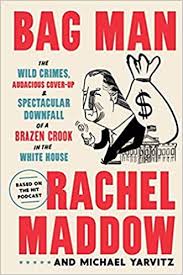
The principle that “no one is above the law” is supposed to be a foundational democratic creed, but political leaders, at least in recent decades, have rarely been held accountable for their malfeasance. In 1974, President Gerald Ford pardoned Richard Nixon after his resignation in response to the Watergate scandal, and Nixon never faced a criminal trial. In the last days of his presidency in 1992, President George H.W. Bush pardoned six of his allies caught up in the Iran-contra scandal. Justice Department regulations formed during Watergate prohibited special counsel Robert Mueller from prosecuting President Trump on charges that he obstructed justice. Whether Trump will be tried in court after he leaves the White House remains in doubt.
In “Bag Man,” MSNBC’s Rachel Maddow and journalist Michael Yarvitz have written a case study in how the democratic ideal of equal justice under the law collides with the squalid realities of America’s political system. Their book, which is based on their podcast of the same name, gives a brisk and engaging account of the effort to hold Vice President Spiro Agnew criminally accountable, and it sheds light on the challenges — legal, moral, political — of treating presidents and vice presidents like every other citizen.
In “Bag Man,” MSNBC’s Rachel Maddow and journalist Michael Yarvitz have written a case study in how the democratic ideal of equal justice under the law collides with the squalid realities of America’s political system. This book is based on their podcast with same name, gives a brisk and engaging account of the effort to hold Vice President criminally accountable, and it sheds light on the challenges, legal, moral, political and treating presidents and vice presidents like every other citizen.

Media personalities tend to favor history built on baseless conspiracy theories, such as Bill O’Reilly’s “Killing Lincoln” (which falsely implicates Secretary of War Edwin Stanton in Lincoln’s assassination), or rooted in national celebration (think Tom Brokaw’s “The Greatest Generation”). In “Bag Man,” however, Maddow and Yarvitz adopt a more trenchant approach, basing their storytelling on archival research and oral histories that yield fresh details about the ordeal confronting prosecutors investigating Agnew’s abuses of power.
Based at a Justice Department office in Baltimore, U.S. Attorney George Beall, a Republican in his mid-30s, and Assistant U.S. Attorneys Ron Liebman, Tim Baker and Barney Skolnik unearthed evidence that Agnew — as Baltimore County executive, as Maryland governor and as vice president — accepted envelopes full of cash from builders in exchange for steering them government construction contracts. The government lawyers found a welcome ally in Elliot Richardson, Nixon’s attorney general, who courageously urged his colleagues to pursue a case against the vice president.
If the case felt airtight to the lawyers, actually bringing it to trial was a different matter altogether. “The kids from Baltimore were pushing hard for the punishment they believed Agnew deserved,” Maddow and Yarvitz write. “People who do this s— go to jail,” Skolnik recalled thinking to himself. And “the message if he doesn’t go to jail is that if you’re big enough, if you’re powerful enough, you don’t get treated like everybody else.”
But the no-one-is-above-the-law principle bumped up against the power of Agnew’s position, partisan politics and the metastasizing Watergate scandal. Beall’s brother, a GOP senator from Maryland, along with Republican National Committee Chairman George Bush and other GOP luminaries, applied subtle pressure on the Justice Department to soft-pedal the investigation. The lawyers didn’t buckle.
Agnew complained in public that it was a witch hunt, part of a liberal-media plot to destroy a leader who had dared to take on the political establishment. Most concerning to Richardson, Watergate was imperiling Nixon’s presidency; if Nixon resigned or was impeached, letting Agnew become president while he was under investigation for bribery would plunge the country into another abyss.
Justice Department lawyers had conversations about the best thing “to do for the country.” What was the right way to achieve equal justice under the law? What outcome would advance “the national interest”? Richardson overruled his line attorneys and negotiated a deal with Agnew’s lawyers: In exchange for a no-contest plea to a single charge of tax evasion and his resignation from the vice presidency, Agnew would avoid criminal prosecution and jail time. Stopping Agnew from becoming president overrode the need to seek justice in a courtroom for his abuses of power.
In these pages, Agnew is depicted as an archetype of Trump’s hard-right slash-and-burn style of politics. Bashing liberal politicians as “radic-libs” and television news broadcasters as “hopeless, hysterical hypochondriacs of history,” Agnew used us-against-them cultural frames to enlist the die-hard backing of an emerging White working-class GOP base. The vice president’s oratory made him “a singularly divisive national figure,” the authors write.
At times, though, the Agnew-as-Trump analogy is overwrought. The authors give Agnew too much credit for innovating a brand of politics that owed as much, if not more, to the era’s grass-roots conservative mobilization, the growing influence of far-right media, and leaders even more influential than Agnew such as Joe McCarthy, Roy Cohn, George Wallace, Phyllis Schlafly and Newt Gingrich. (Also left unaddressed is whether Agnew might have survived in office had Fox News and Twitter existed to defend him in the early 1970s.)
Some of the writing tends toward the glib. The authors write that Beall, facing pressure to let Agnew go, “took the heat, all of it.” In summing up Frank Sinatra’s support for Agnew’s legal defense fund after the vice president defended Sinatra from allegations of mob ties, Maddow and Yarvitz observe that the singer “returned the favor, Ocean’s-11 style.”
“Bag Man” is also partial to a good-and-evil theme that crowds out nuance and reflects the limits of turning partisan cable television and podcasting into sober-minded historical analysis. The authors quote one of the prosecutors referring to Agnew as pure “evil,” a description that doesn’t really help explain how someone who could rise to the vice presidency would also engage in such a long-running criminal enterprise, or the sources that undergirded Agnew’s deep well of political support.
Nonetheless, this fast-paced and well-researched book underscores how the nation’s legal and political systems struggle to hold the most powerful elected leaders responsible for their crimes. In the end, Agnew resigned. Like Nixon, however, he never went to jail and never stood trial. He went on to poison the public sphere when he published a conspiracy-laden and anti-Semitic novel, and lived out his days without ever experiencing the full consequences that probably should have flowed from his years of abusing the public trust.
Bag Man
The Wild Crimes, Audacious Cover-up, and Spectacular Downfall of a Brazen Crook in the White House
By Rachel Maddow and Michael Yarvitz
Publisher : Crown (December 8, 2020) Hardcover : 304 pages Price $16.74
Disclosure: This post is brought to you by aamadmikifaryad.wordpress. We highlight products and services you might find interesting. If you buy them, we get a small share of the revenue from the sale from our commerce partners. We frequently receive products free of charge from manufacturers to test. This does not drive our decision as to whether or not a product is featured or recommended. We welcome your feedback. Email us at futureoftheworldin2050@gmail.com
The Best Books of the Year 2020




